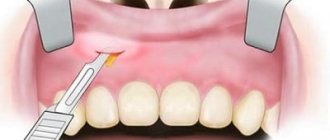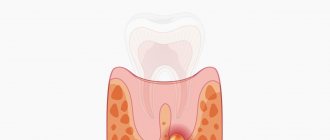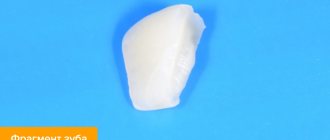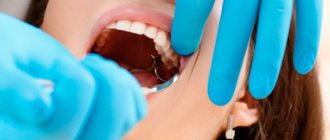28.10.2019
Removing or extracting a tooth is an unpleasant procedure. After the operation, tissue healing awaits. How many days will it take for the sutures to be removed from the gums, what can and cannot be done before and after removal of the sutures - such questions torment patients.
Why do you need stitches after wisdom tooth removal?
Removing the “eight” is a surgical procedure that involves dissecting the tissue in the area of the “wise” tooth. After the tooth is extracted, the gum must be sutured so that it heals without complications. A classic example is when, after suturing, a person is scheduled for a follow-up visit to the dentist. At this stage, it is important to evaluate the process of tissue regeneration and make sure that there are no complications after wisdom tooth removal.
When else do you need stitches? For example, when a dental operation needs to be performed urgently, the dentist does not have the opportunity or time to perform blood clotting tests on the patient (a common picture during dental operations after injuries). In this case, the stitches perform the task of preventing bleeding.
When to remove gum sutures
Even if the wound was sutured with a self-absorbing thread, it is worth checking with your doctor whether it needs to be removed and when. The surgeon must ensure that the operation performed does not cause late complications. Therefore, you need a second visit to him after 7-10 days to determine how many days later to remove the sutures from the gums.
If there is no swelling, redness, or pain, the doctor will remove the stitches. If tissue healing is incomplete, you may need another visit in 2-3 days, during which the material used to close the wound will be removed.
Does it hurt to take it off?
When the suture thread is removed, the patient feels discomfort. Pain when pulling out suture material is rare, due to individual sensitivity or in the presence of a complication in the form of inflammation. If the patient's pain threshold is reduced, superficial anesthesia with Novocaine or Lidocaine spray is used.
How to remove sutures on the gums
Before removing stitches:
- The surgeon will treat the oral cavity with an antiseptic.
- Examine the mucous membrane of the oral cavity: it is necessary that there is no pain, fever, redness, swelling, and no fluid or pus is released from the wound area.
- The thread is cut with a special dental instrument. When the seam is continuous, the cut will be in several places; if it is intermittent, then all the stitches will be cut in half.
- Using fingers or tweezers, the surgeon will pull out pieces of thread and check how well the scar is formed on the wound.
After removing the stitches, the patient will rinse their mouth with an antiseptic.
For 1–3 days, unpleasant sensations in the jaw and gums are possible when moving.
The wound after tooth extraction heals completely within 2–3 weeks. In young people this process is faster. The sockets of single-rooted teeth can heal completely on the 14th day, multi-rooted ones - by the 20th day after surgery.
In case of purulent complications, healing will be delayed for a week for a single-rooted tooth, and 2 for a multi-rooted one.
The more traumatic the operation was, the larger the volume of tissue that was subjected to intervention, the longer the healing.
The surgeon still removes the absorbable sutures so that they, being on the gums for a long time, do not provoke inflammation.
Removing the suture material too early may prevent a clot from fully forming in the wound. In this case, inflammation is also possible.
Sometimes patients get in the way of the threads, and the question arises of how to remove the sutures from the gums on their own, at home, if there is no pain or swelling. What to do if the surgeon is far away, and it’s impossible to tolerate when the threads become hard and rub against the tongue or gums, causing irritation of the mucous membrane?
In principle, the stitches can be removed by the patient himself. But this is fraught with infection in the wound.
At home, you must follow all the rules of asepsis and antisepsis; you cannot keep your instruments sterile. Safe removal of the threads used to suture the gum wound is only possible by a dentist.
How do doctors apply stitches?
Sutures are the junction of soft tissues that were cut to remove a wisdom tooth from the socket. As a rule, figure eights “sit” very firmly in the jaw, are attached to the bone by two roots, and sometimes stand unevenly, resting against neighboring teeth. There is no way to do this without a surgical incision.
To carefully remove a molar, the surgeon makes one or two incisions in the gum, after which he loosens the tooth with a special tool and removes it. Bleeding occurs at the root site; sutures are carefully placed with special threads.
The first day after suturing, bleeding should not be too active - it is the sutures that seem to hold it back. They also connect layers of dissected tissue, which naturally grows together. With high-quality sutures, there should be no severe pain or discomfort, and on the third to fifth day after the operation, the person will not feel any swelling of the gums in the operated area.
The sutures prevent infection from entering the open wound. The better the wound is closed with sutures, the lower the risk of complications and accidental infection.
A follow-up visit after surgery is scheduled 5–7 days later. If the patient is bothered by the wound earlier, he makes an emergency visit.
The dentist assesses the condition of the gums, may prescribe an x-ray, and examines the stitches in detail. If the wisdom tooth removal went without complications, the sutures can be removed after a week. If complete healing of the wound has not occurred, the sutures remain for several more days.
Dentistry for those who love to smile
+7
Make an appointment
Types of sutures and materials used in dentistry
To facilitate and accelerate the healing process of postoperative wounds in the oral cavity, the following types of sutures are used:
- nodal - used when it is important to ensure equal tension on both edges of the wound (for example, between teeth);
- continuous - when a violation of the integrity of soft tissue occurs along several dental units;
- single - each stitch is knitted separately from each other.
Threads used for suturing in dentistry can be made of absorbable and non-absorbable material.
Absorbable threads:
- from catgut - which contains a foreign protein, which is perceived by the body as a foreign body, and therefore often causes inflammation of the damaged soft tissue of the patient’s oral cavity;
- “Vicryl” is a synthetic material made from polyclatin and polyglycomic acid, which does not cause the risk of developing inflammatory processes even during complex operations.
Threads made of absorbable material do not require the removal of sutures; they disappear within 2-5 weeks.
Material for non-absorbable threads:
- silk is an easy-to-use material, highly durable, but has a significant drawback - it causes inflammatory processes in soft tissues if not removed 7 to 10 days after surgery;
- monofilament is a thread made of polytetrafluoroethylene, which is durable and does not cause inflammation, but has a rigid structure that can damage the mucous membrane. To exclude this possibility, a bandage is applied to the wound surface;
- polyester is a woven thread often coated with silicone for elasticity and smoothness. A very durable material that does not lead to inflammatory processes, but requires careful fixation in the form of knots.
How to understand that complications have arisen after suturing?
Alarming symptoms after removing the “eight” are as follows:
- heavy bleeding that lasts more than a day;
- severe pain, throbbing pain that prevents you from sleeping or leading a normal life;
- very large swelling;
- redness in the intervention area;
- blood in saliva in the first three days after the intervention;
- elevated body temperature.
In all these cases, you must consult your doctor. It is possible that stitches will have to be stitched again to avoid complications.
Remember that removing teeth does not hurt, and removing stitches does not hurt either! The main thing is that this work is performed by a professional.
Possible complications
Pain and swelling of the gums at rest, difficulty chewing, evening fever in the first two days after surgery and suturing are considered normal - this is a response to surgical trauma. If the symptoms increase, it means that a purulent complication is developing. A visit to the doctor is needed, opening the wound with removal of the suture threads, washing it, re-suturing or draining it, and taking antibiotics.
Complications arise when wound hygiene is not observed, infection occurs, or particles of a tooth or root are left in the wound.
Continued bleeding from the surgical area is possible if the stitches come apart.
Seam divergence
If the suture breaks apart after tooth extraction, this may indicate inflammation of the periosteum - periostitis.
When infected, the wound area swells, there is pain, discharge of pus, which can push out the threads, and the edges of the tissue diverge. Healing is delayed, and there is a risk of developing ugly scars.
If the sutures on the gums come apart, it is necessary to visit a surgeon to determine the cause and eliminate it with re-suturing of the wound in the oral cavity.
Maintains healthy gums by maintaining oral hygiene and following the dentist’s recommendations after any dental surgery.
Duration of wearing bandages in dentistry
Depending on the properties and purposes, the duration of wearing the bandage is determined:
- with a therapeutic effect - from 2-3 hours to 3-4 days. They mainly use gauze and bandages, applying the necessary drugs that have antimicrobial and anti-inflammatory properties to them;
- for protection purposes, adhesive, semi-solid and hard dressings are often used, capable of fixing the application for 4-7 days;
- collagen films - have the possibility of the longest rehabilitation period (up to 20 days). Can be used as a bandage after surgery and as an independent treatment for bedsores from dentures.
A variety of dressing materials allows dentists to minimize the risk of postoperative complications.
Types of operations for osteoplasty and sinus lifting
As already written above, sinus lifting is a type of osteoplasty, but in addition to this type of surgical intervention, there are also techniques that are often used in traditional maxillofacial surgery. Bone grafting techniques are divided into two large groups:
- Transplantation of an autogenous or other type of implant. As a result of this type of osteoplasty, the height and/or width of the alveolar ridge can be effectively increased.
- Splitting technique on the mandibular or maxillary bone when the width of the bone tissue is insufficient. This operation is less traumatic and has another advantage, as it allows you to simultaneously install an implant for an artificial tooth.
Whatever the operation, minimally invasive or conventional, soft tissues are still injured, which subsequently need to be sutured. Maxillofacial surgeons mainly use synthetic, especially strong threads that can either dissolve within 2-4 weeks or not. Non-absorbable threads are made from silk, polystyrene and polytetrafluoroethylene.
Silk threads have proven themselves to be durable and mobile in terms of tying knots. But there is a drawback: they contain a protein that can cause an allergic reaction. Polystyrene threads are as strong as silk, but do not cause any allergic or inflammatory reactions and are a good choice for use in maxillofacial surgery. Polytetrafluoroethylene or monofilament threads are also widely used in surgery and have good anti-inflammatory and adaptive abilities. They are often used to secure periodontal membranes. But they are quite rigid at the edges, and they should be covered with bandages so as not to cause trauma to the soft tissues of the cheeks and lips.
Absorbable ones include natural (catgut) and synthetic (Dexon, Vicryl).
These threads have anti-inflammatory properties and are widely used in surgery, but they require special knowledge in tying knots.
Causes of seam divergence
The seams after screwing in the implant may come apart for various reasons. The main ones are:
- the patient violates the doctor’s recommendations regarding care of the postoperative area;
- poor oral hygiene;
- the doctor made a mistake when performing treatment and used low-quality materials;
- individual intolerance to the materials used;
- serious damage to the jaw bone.
When should wisdom teeth not be removed?
It is not always necessary to remove the “eights”, but sometimes it is vitally necessary, so there are no absolute contraindications to such operations. Relative contraindications include:
- severe decompensated diseases of internal organs - condition after myocardial infarction, stroke, hypertensive crisis, severe kidney and liver diseases;
- malignant tumors at the site of surgery;
- any acute diseases and exacerbation of chronic diseases;
- severe bleeding disorders;
- allergies to painkillers;
- purulent-inflammatory processes in the oral cavity.
Removal of the “eight” is carried out after treatment of these pathologies, elimination of the threat to life and the risk of possible complications in the patient. Pregnancy and lactation are also relative contraindications, and if necessary, third molars are still removed.
Relative contraindications also include the absence of a second molar or “seven” in the patient. Therefore, if it is possible to cure the third molar, then it is better not to remove it: it will take the place of the “seven” and will be a support for prosthetics.
What to do if the suture breaks after implantation
There are times when the threads have weakened and come apart. This does not threaten the implant falling out, but there is a risk of infection . The situation must be corrected urgently.
After the examination, the doctor will take the necessary antiseptic measures and prescribe rinses. The recovery period after long complex operations is sometimes accompanied by antibiotic therapy. The rehabilitation course for each patient is compiled individually. If the tissues have not yet fused, the specialist will have to remove the stitches and then apply new ones.
Recommendations for oral care after surgery
After applying stitches, you must follow a number of rules:
- Do not pick at the wound again, do not touch it with your hands or tongue
- Don't eat too fatty foods
- It is better to give up solid foods - apples, nuts, seeds
- Do not try to remove stitches yourself
- Rinse your mouth with Rotokan solution and other means prescribed by your doctor.
- It is recommended to brush your teeth with a new toothbrush
- It is not recommended to use dental floss near the suture site.
- Don't drink alcohol
- Do not use medications that thin the blood
- Do not drink coloring or too hot drinks - coffee, black tea, lemonade, soda
- Do not try to stop the bleeding if intense bleeding occurs using self-prescribed medications. It is better to go to a 24-hour dental clinic or call a doctor at home.
What to do next
The implantation process is quite long. After the threads are removed, the mucous membrane continues to grow over the implant. It shouldn't be visible. This takes approximately two months. Then prosthetics are performed. Installed orthopedic structures require careful care. The patient needs to master the technique of daily procedures that will help maintain a beautiful, healthy smile for a long time. These include:
- using a brush with soft bristles;
- brushing teeth twice a day;
- flossing;
- cleaning the areas where the implants come into contact with the gums using an irrigator;
- If plaque has formed, visit the dental office to remove it.
Patients who have undergone implantation should periodically visit specialists. This will help extend the service life of structures and avoid complications.
Briefly about the introduction of dental implants
To install a metal structure into the bone tissue, it is necessary to make an incision in the mucous membrane. At the end of the surgical intervention, suturing is required. If the outcome of the operation is favorable and there are no consequences, the surgical threads are removed after about 10 days.
The operation process itself is completely painless for the patient, this is thanks to high-quality anesthetic drugs. A little pain is possible only during the rehabilitation period. If you follow all the doctor’s recommendations, all troubles can be avoided, however, not always everything depends only on the patient’s behavior.











